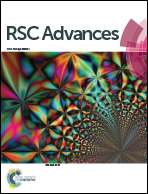Evaluation of 4-alkoxy-4′-nitrobiphenyl liquid crystals for use in next generation scattering LCDs†
Abstract
We have prepared nine members of the 4-alkoxy-4′-nitrobiphenyl family of liquid crystals and evaluated their thermal behaviour by a combination of polarised optical microscopy, differential scanning calorimetry and small angle X-ray scattering, as well as in single pixel scattering devices for use in backlight free liquid crystal displays (LCDs). Whereas homologues with shorter terminal aliphatic chains are nematogenic, those with longer aliphatic chain lengths exhibit an additional smectic A phase, identified as the subtype SmAD by SAXS with all materials having a D/L ratio (smectic layer spacing divided by molecular length) of 1.4. When doped with 0.1 wt% hexadecyltrimethylammonium perchlorate we observed that the SmAD phase of compound 9 could be switched with a relatively low voltage (58 VRMS, roughly half that required for the analogous nitrile). This apparent reduction in threshold voltage, which occurs as a consequence of switching from a nitrile- to a nitro- group, provides a new impetus to study alternative polar terminal groups when designing host materials for smectic A scattering devices.



 Please wait while we load your content...
Please wait while we load your content...